Climatic Trends in Different Bioclimatic Zones in the Chitwan Annapurna Landscape, Nepal
Abstract
1. Introduction
2. Materials and Methods
2.1. Study Area
2.2. Climate Analysis
2.3. Data Management
2.4. Trend Analysis
2.5. Lapse Rate of Temperature and Precipitation
3. Result
3.1. Annual Trend of Precipitation
3.2. Precipitation Trends in Different Decades
3.3. Annual Trend of Temperature
3.4. Temperatures in Different Decades
3.5. Average Annual Temperature and Precipitation
3.6. Lapse Rate of Temperature and Precipitation Lapse Rate
4. Discussion
5. Conclusions
Author Contributions
Funding
Acknowledgments
Conflicts of Interest
Appendix A
| Station Name | Station ID | Station Type | District | Latitude | Longitude | Altitude (m) | Data Available |
|---|---|---|---|---|---|---|---|
| Lower tropical bioclimatic zone (<500 m) | |||||||
| Dumkauli | 706 | Agro-meteorology | Nawalparasi | 28.1 | 84.22 | 154 | 1976 |
| Simari | 728 | Climatology | Nawalparasi | 28.12 | 83.75 | 154 | 1981 |
| Chapakot | 810 | Climatology | Syangja | 27.88 | 83.82 | 460 | 1979 |
| Rampur | 902 | Agro-meteorology | Chitwan | 28.02 | 84.42 | 256 | 1970 |
| Hetauda NFI | 906 | Climatology | Makawanpur | 27.68 | 85.05 | 474 | 1971 |
| Upper tropical bioclimatic zone (500–1000 m) | |||||||
| Baglung | 605 | Climatology | Baglung | 27.93 | 83.6 | 984 | 1978 |
| Beni bazar | 609 | Climatology | Myagdi | 27.53 | 83.57 | 835 | 1989 |
| Kusma | 614 | Climatology | Parbat | 28.28 | 83.7 | 891 | 1989 |
| Khudi bazar | 802 | Climatology | Lamjung | 28.3 | 84.37 | 823 | 1970 |
| Pokhara airport | 804 | aeronautical | Kaski | 28.03 | 84.0 | 827 | 1970 |
| Syangja | 805 | Climatology | Syangja | 27.62 | 83.88 | 868 | 1976 |
| Malepatan | 811 | Agro-meteorology | Kaski | 27.92 | 84.12 | 856 | 1970 |
| Khairenitar | 815 | Climatology | Tanahu | 28.1 | 84.1 | 500 | 1970 |
| Lower subtropical bioclimatic zone (1000–1500 m) | |||||||
| Tansen | 702 | Climatology | Palpa | 28.22 | 83.53 | 1067 | 1972 |
| Gorkha | 809 | Agro-meteorology | Gorkha | 28 | 84.62 | 1097 | 1970 |
| Nuwakot | 1004 | Climatology | Nuwakot | 27.93 | 85.02 | 1003 | 1970 |
| Pensayakhola | 1057 | Climatology | Nuwakot | 28.28 | 85.12 | 1240 | 1975 |
| Upper subtropical bioclimatic zone (1500–2000 m) | |||||||
| Khachikot | 715 | Climatology | Arghakhanchi | 28 | 83.15 | 1760 | 1977 |
| Tamghas | 725 | Climatology | Gulmi | 27.88 | 83.25 | 1530 | 1981 |
| Lumle | 814 | Agro-meteorology | Kaski | 27.8 | 83.8 | 1740 | 1970 |
| Dhunche | 1055 | Climatology | Rasuwa | 28.1 | 85.3 | 1982 | 1989 |
| Temperate bio climatic zone (2000–2500 m) | |||||||
| Jomsom | 601 | Climatology | Mustang | 27.87 | 83.72 | 2744 | 1970 |
| Thakmarpha | 604 | Agro-meteorology | Mustang | 27.68 | 83.7 | 2566 | 1970 |
| Daman | 905 | Climatology | Makawanpur | 27.87 | 85.08 | 2314 | 1972 |
| Lete | 607 | Climatology | Mustang | 28.07 | 83.6 | 2384 | 1998 |
| Kakani | 1007 | Agro-meteorology | Nuwakot | 28.07 | 85.25 | 2064 | 1972 |
Appendix B
| Station Name | Station ID | Station Type | District | Latitude | Longitude | Altitude |
|---|---|---|---|---|---|---|
| Lower tropical bioclimatic zone (<500 m) | ||||||
| Ridi bazar | 701 | Precipitation | Gulmi | 27.95 | 83.43 | 442 |
| Beluwa (girwari) | 704 | Precipitation | Nawalparasi | 27.68 | 84.05 | 150 |
| Dumkauli | 706 | Agrometeorology | Nawalparasi | 27.68 | 84.22 | 154 |
| Dumkibas | 710 | Precipitation | Nawalparasi | 27.58 | 83.87 | 164 |
| Chapkot | 810 | Climatology | Syangja | 27.88 | 83.82 | 460 |
| Damauli | 817 | Climatology | Tanahun | 27.97 | 84.28 | 358 |
| Rampur | 902 | Agrometeorology | Chitawan | 27.62 | 84.42 | 256 |
| Jhawani | 903 | Precipitation | Chitawan | 27.58 | 84.53 | 270 |
| Hetaundan.f.i. | 906 | Climatology | Makwanpur | 27.42 | 85.05 | 474 |
| Beluwa(manahari) | 920 | Precipitation | Makwanpur | 27.55 | 84.82 | 274 |
| Bharatpur | 927 | Climatology | Chitawan | 27.67 | 84.43 | 205 |
| Upper tropical bioclimatic zone (500–1000 m) | ||||||
| Baglung | 605 | Climatology | Baglung | 28.27 | 83.60 | 984 |
| Beni bazar | 609 | Climatology | Myagdi | 28.35 | 83.57 | 835 |
| Kushma | 614 | Climatology | Parbat | 28.22 | 83.70 | 891 |
| Garakot | 726 | Precipitation | Palpa | 27.87 | 83.80 | 500 |
| Khudi bazar | 802 | Climatology | Lamjung | 28.28 | 84.37 | 823 |
| Pokhara airport | 804 | Aeronatical | Kaski | 28.22 | 84.00 | 827 |
| Syangja | 805 | Climatology | Syangia | 28.10 | 83.88 | 868 |
| Kunchha | 807 | Precipitation | Lamiung | 28.13 | 84.35 | 855 |
| Bandipur | 808 | Climatology | Tanahun | 27.93 | 84.42 | 965 |
| Malepatan | 811 | Agrometeorology | Kaski | 28.12 | 84.12 | 856 |
| Khairinitar | 815 | Agrometeorology | Tanahun | 28.03 | 84.10 | 500 |
| Arughatbazar | 1002 | Precipitation | Dhading | 28.05 | 84.82 | 518 |
| Lower subtropical bioclimatic zone (1000–1500 m) | ||||||
| Tatopani | 606 | Precipitation | Myagdi | 28.48 | 83.65 | 1243 |
| Tansen | 702 | Climatology | Palpa | 27.87 | 83.53 | 1067 |
| Musikot | 722 | Precipitation | Gulmi | 28.17 | 83.27 | 1280 |
| Jagat (setibas) | 801 | Precipitation | Gorkha | 28.37 | 84.90 | 1334 |
| Gorkha | 809 | Agrometeorology | Gorkha | 28.00 | 84.62 | 1097 |
| Lamachaur | 818 | Precipitation | Kaski | 28.27 | 83.97 | 1070 |
| Pamdur | 830 | Precipitation | Kaski | 28.27 | 84.78 | 1160 |
| Makwanpurgadhi | 919 | Precipitation | Makwanpur | 27.42 | 85.17 | 1030 |
| Nuwakot | 1004 | Climatology | Nuwakot | 27.92 | 85.17 | 1003 |
| Dhading | 1005 | Precipitation | Dhading | 27.87 | 84.93 | 1420 |
| Pansayakhola | 1057 | Precipitation | Nuwakot | 28.02 | 85.12 | 1240 |
| Upper subtropical bioclimatic zone (1500–2000 m) | ||||||
| Karki neta | 613 | Precipitation | Parbat | 28.18 | 83.75 | 1720 |
| Khanchikot | 715 | Climatology | Arghakhanchi | 27.93 | 83.15 | 1760 |
| Tamghas | 725 | Climatology | Gulmi | 28.07 | 83.25 | 1530 |
| Lumle | 814 | Agrometeorology | Kaski | 28.30 | 83.80 | 1740 |
| Ghandruk | 821 | Precipitation | Kaski | 28.38 | 83.80 | 1960 |
| Chisapanigadhi | 904 | Precipitation | Makwanpur | 27.55 | 85.13 | 1706 |
| Markhugaun | 915 | Precipitation | Makwanpur | 27.62 | 85.15 | 1530 |
| Timure | 1001 | Climatology | Rasuwa | 28.28 | 85.38 | 1900 |
| Thamachit | 1054 | Precipitation | Rasuwa | 28.17 | 85.32 | 1847 |
| Dhunche | 1055 | Climatology | Rasuwa | 28.10 | 85.30 | 1982 |
| Lower temperate bioclimatic zone (2000–2500 m) | ||||||
| Lete | 607 | Climatology | Mustang | 28.63 | 83.60 | 2384 |
| Bobang | 615 | Precipitation | Baglung | 28.40 | 83.10 | 2273 |
| Daman | 905 | Climatology | Makwanpur | 27.60 | 85.08 | 2314 |
| Kakani | 1007 | Agrometeorology | Nuwakot | 27.80 | 85.25 | 2064 |
| Upper temperate bioclimatic zone (2500–3000 m) | ||||||
| Jomsom | 601 | Climatology | Mustang | 28.78 | 83.72 | 2744 |
| Thakmarpha | 604 | Agrometeorology | Mustang | 28.75 | 83.70 | 2566 |
| Gurjakhani | 616 | Climatology | Myagdi | 28.60 | 83.22 | 2530 |
| Chame | 816 | Climatology | Manang | 28.55 | 84.23 | 2680 |
| Lower subalpine bioclimatic zone (3000–3500 m) | ||||||
| Ghami (mustang) | 610 | Precipitation | Mustang | 29.05 | 83.88 | 3465 |
| Manangbhot | 820 | Climatology | Manang | 28.67 | 84.02 | 3420 |
| Alpine bioclimatic zone (3500–4000 m) | ||||||
| Ranipauwa (m.nath) | 608 | Precipitation | Mustang | 28.82 | 83.88 | 3609 |
| Mustang(lomangthang | 612 | Climatology | Mustang | 29.18 | 83.97 | 3705 |
| Larkesamdo | 806 | Precipitation | Gorkha | 28.67 | 84.62 | 3650 |
References
- Palazzi, E.; Filippi, L.; Hardenberg, J.V. Insights into elevation dependent warming in the Tibetan plateau-Himalayas from CMIP5 model simulations. Clim. Dyn. 2016. [Google Scholar] [CrossRef]
- DHM. Observed Climate Trend Analysis in the Districts and Physiographic Regions of Nepal (1971–2014); Department of Hydrology and Meteorology: Kathmandu, Nepal, 2017. [Google Scholar]
- IPCC. Summary for Policymakers. In Global Warming of 1.5 °C. An IPCC Special Report on the Impacts of Global Warming of 1.5 °C above Pre-Industrial Levels and Related Global Greenhouse Gas Emission Pathways, in the Context of Strengthening the Global Response to the Threat of Climate Change, Sustainable Development, and Efforts to Eradicate Poverty; Masson-Delmotte, V., Zhai, P., Pörtner, H.-O., Roberts, D., Skea, J., Shukla, P.R., Pirani, A., Moufouma-Okia, W., Péan, C., Pidcock, R., et al., Eds.; Cambridge University Press: Cambridge, UK, 2018. [Google Scholar]
- Rangwala, I.; Miller, J.R. Climate change in mountains - a review of elevation dependent warming and its possible causes. Clim. Chang. 2012, 114, 527–547. [Google Scholar] [CrossRef]
- MoFE. Climate Change Scenarios for Nepal for National Adaptation Plan (NAP); Ministry of Forests and Environment: Kathmandu, Nepal, 2019. [Google Scholar]
- Parmesan, C.; Yohe, G. A globally coherent fingerprint of climate change impacts across natural systems. Nature 2003, 42, 37–42. [Google Scholar] [CrossRef]
- Shrestha, M.L. Development of climate change scenarios with reference to Nepal. In Proceedings of the Workshop on Climate Change in Nepal; Department of Hydrology and Meteorology: Kathmandu, Nepal, 1997; pp. 16–32. [Google Scholar]
- DHM. Proceedings of the Workshop on Climate Change in Nepal; Department of Hydrology and Meteorology: Kathmandu, Nepal, 1997. [Google Scholar]
- Shrestha, A.B.; Wake, C.P.; Mayewski, P.A.; Dibb, J.E. Maximum temperature trends in the Himalaya and its vicinity: An analysis based on temperature records from Nepal for the period 1971–94. J. Clim. 1999, 12, 2775–2786. [Google Scholar] [CrossRef]
- Baidya, S.K.; Regmi, R.K.; Shrestha, M.L. Climate Profile and Observed Climate Change and Climate Variability in Nepal; APN CAPABLE Report; Department of Hydrology and Meteorology: Kathmandu, Nepal, 2007. [Google Scholar]
- Karmacharya, J.; Shrestha, A.; Shrestha, M.L. Climate Change Scenarios for South Asia and Central Himalayan Region Based on GCM Ensemble; APN CAPABLE Report; Department of Hydrology and Meteorology: Kathmandu, Nepal, 2007. [Google Scholar]
- Baidya, S.K.; Shrestha, M.L.; Shiekh, M.M. Trends in daily extremes of temperature and precipitation in Nepal. J. Hydrol. Meteorol. 2008, 5, 38–51. [Google Scholar]
- NCVST. Vulnerability through the Eyes of Vulnerable: Climate Change Induced Uncertainties’ and Nepal’s Development Predicaments; Institute for Social and Environmental Transition-Nepal (ISET-N, Kathmandu) and Institute for Social and Environmental Transition (ISET, Boulder, Colorado) for Nepal Climate Vulnerability Study Team: Kathmandu, Nepal, 2009. [Google Scholar]
- Practical Action. Understanding Disaster Management in Practice with Reference to Nepal; Practical Action: Kathmandu, Nepal, 2009. [Google Scholar]
- Shrestha, U.B.; Gautam, S.; Bawa, K.S. Widespread climate change in the Himalayas and associated changes in local ecosystems. PLoS ONE 2012, 7, e36741. [Google Scholar] [CrossRef]
- Panthi, J.; Dahal, P.; Shrestha, M.; Aryal, S.; Krakauer, N.; Pradhanang, S.; Lakhankar, T.; Jha, A.; Sharma, M.; Karki, R. Spatial and temporal variability of rainfall in the Gandaki River Basin of Nepal Himalaya. Climate 2015, 3, 210–226. [Google Scholar] [CrossRef]
- Nepal, S. Impacts of climate change on the hydrological regime of the Koshi river basin in the Himalayan region. J. Hydro-Environ. Res. 2016, 10, 76–89. [Google Scholar] [CrossRef]
- Khatiwada, K.; Panthi, J.; Shrestha, M.; Nepal, S. Hydro-climatic variability in the Karnali river basin of Nepal Himalaya. Climate 2016, 4, 17. [Google Scholar] [CrossRef]
- Agrawal, A.; Babel, M.S.; Maskey, S.; Shrestha, S.; Kawasaki, A.; Tripathi, N.K. Analysis of temperature projections in the Koshi River Basin, Nepal. Int. J. Climatol. 2016, 36, 266–279. [Google Scholar] [CrossRef]
- Manadal, R.A. Weather station and annual temperature dynamics in the elevation gradient (spatial and temporal analysis of Chitwan-Annapurna, Nepal). J. Hist. Archeol. Anthropol. Sci. 2020, 5, 37–44. [Google Scholar]
- MoFSC. Strategy and Action Plan 2016–2025, Chitwan Annapurna Landscape, Nepal; Ministry of Forests and Soil Conservation: Kathmandu, Nepal, 2015. [Google Scholar]
- Dobremez, J.F. Ecology and Biogeography of Nepal; National Scientific Research Centre: Paris, France, 1976. (In French) [Google Scholar]
- TISC. Forest and Vegetation Types of Nepal; Tree Improvement and Silviculture Component (TISC), TISC documentation series No 105; Department of Forest, HMG/NARMSAP: Kathmandu, Nepal, 2002. [Google Scholar]
- MoE. National Adaptation Programme of Action (NAPA) to Climate Change; Ministry of Environment, Government of Nepal: Kathmandu, Nepal, 2011.
- Karpouzos, D.K.; Kavalieratou, S.; Babajimopoulos, C. Trend analysis of precipitation data in Pieria Region (Greece). Eur. Water. 2010, 30, 31–40. [Google Scholar]
- Partal, T.; Kahya, E. Trend analysis in Turkish precipitation data. Hydrol. Process. 2006, 20, 2011–2026. [Google Scholar] [CrossRef]
- R Core Team. R: A Language and Environment for Statistical Computing; R Foundation for Statistical Computing: Vienna, Austria, 2013; Available online: http://www.R-project.org/ (accessed on 21 March 2020).
- Petersen, L.; Pellicciotti, F. Spatial and temporal variability of air temperature on a melting glacier: Atmospheric controls, extrapolation methods and their effect on melt modeling, Juncal Norte Glacier, Chile. J. Geophys. Res. 2011, 116, D23109. [Google Scholar] [CrossRef]
- Kattel, D.B.; Yao, T.; Yang, K.; Tian, L.; Yang, G.; Joswiak, D. Temperature lapse rate in complex mountain terrain on the southern slope of the central Himalayas. Theor. Appl. Climatol. 2013, 113, 671–682. [Google Scholar] [CrossRef]
- Tang, Z.; Fang, J. Temperature variation along the northern and southern slopes of Mt. Taibai, China. Agric. For. Meteorol. 2006, 139, 200–207. [Google Scholar] [CrossRef]
- Shrestha, A.B.; Wake, C.P.; Dibb, J.E.; Mayewski, P.A. Precipitation fluctuations in the Nepal Himalaya and its vicinity and relationship with some large scale climatological parameters. Int. J. Climatol. 2000, 20, 317–327. [Google Scholar] [CrossRef]
- Poudel, S.; Shaw, R. The relationships between climate variability and crop yield in a mountainous environment: A case study in Lamjung district, Nepal. Climate 2016, 4, 13. [Google Scholar] [CrossRef]
- Luitel, D.R.; Siwakoti, M.; Jha, P.K. Relationship between Climatic Variables and Finger Millet Yield in Syangja, Central Nepal. J. For. Livelihood 2018, 16, 1–13. [Google Scholar]
- McSweeney, C.; New, M.; Lizcano, G. Nepal. UNDP Climate Change Country Profiles Series. 2012. Available online: http://www.geog.ox.ac.uk/research/climate/projects/undp-cp/index.html?country=Nepal&d1=Reports (accessed on 20 March 2020).
- DHM. Study of Climate and Climatic Variation over Nepal; A final report submitted to Ministry of science, technology and environment; Department of Hydrology and Meteorology: Kathmandu, Nepal, 2015.
- MoSTE. Nepal Second National Communication to United Nations Framework Convention on Climate Change; Ministry of Science, Technology and Environment: Kathmandu, Nepal, 2014. Available online: http://unfccc.int/resource/docs/natc/nplnc2.pdf (accessed on 20 March 2020).
- Shrestha, M.L. Inter-annual variation of summer monsoon rainfall over Nepal and its relation to Southern Oscillation Index. Meteorol. Atmos. Phys. 2000, 75, 21–28. [Google Scholar] [CrossRef]
- Dawadi, B. Climatic records and linkage along an altitudinal gradient in the southern slope of Nepal Himalaya. J. Nepal Geol. Soc. 2017, 53, 47–56. [Google Scholar] [CrossRef]
- Kansakar, S.R.; Hannah, D.M.; Gerrard, J.; Rees, G. Spatial pattern in the precipitation regime in Nepal. Int. J. Climatol. 2004, 24, 1645–1659. [Google Scholar] [CrossRef]
- Putkonen, J.K. Continuous Snow and Rain Data at 500 to 4400 m altitude near Annapurna, Nepal, 1999–2001. Arct. Antarct. Alp. Res. 2004, 36, 244–248. [Google Scholar] [CrossRef]
- WESC. Water Resources of Nepal in the Context of Climate Change; Water and Energy Commission Secretariat, Singhadurbar: Kathmandu, Nepal, 2011.
- Sharma, K.P.; Vorosmarty, C.J.; Moore, B., III. Sensitivity of the Himalayan Hydrology to Land-use and Climatic Changes. In Climatic Change 47; Kluwer Academic Publishers: Dordrecht, The Netherlands, 2000; pp. 117–139. [Google Scholar]
- Hansen, J.; Sato, M.; Ruedy, R.; Lo, K.; Lea, D.W.; Elizade, M. Global Temperature Change. Proc. Natl. Acad. Sci. USA 2006, 103, 14288–14293. [Google Scholar] [CrossRef] [PubMed]
- Chen, B.; Chao, W.C.; Liu, X. Enhanced climatic warming in the Tibetan plateau due to doubling CO2: A model study. Clim. Dyn. 2003, 20, 401–413. [Google Scholar] [CrossRef]
- ICIMOD. Snow Cover Statistics- Nepal; E-bulletin: International Centre for Integrated Mountain Development (ICIMOD): Lalitpur, Nepal, 2013. [Google Scholar]
- Heynen, M.; Miles, E.; Ragettli, S.; Buri, P.; Immerzeel, W.W.; Pellicciotti, F. Air temperature variability in a high-elevation Himalayan catchment. Ann. Glaciol. 2016, 57. [Google Scholar] [CrossRef]
- Immerzeel, W.W.; Petersen, L.; Ragettli, S.; Pellicciotti, F. The importance of observed gradients of air temperature and precipitation for modeling runoff from a glacierized watershed in the Nepalese Himalayas. Water Resour. Res. 2014, 50, 2212–2226. [Google Scholar] [CrossRef]
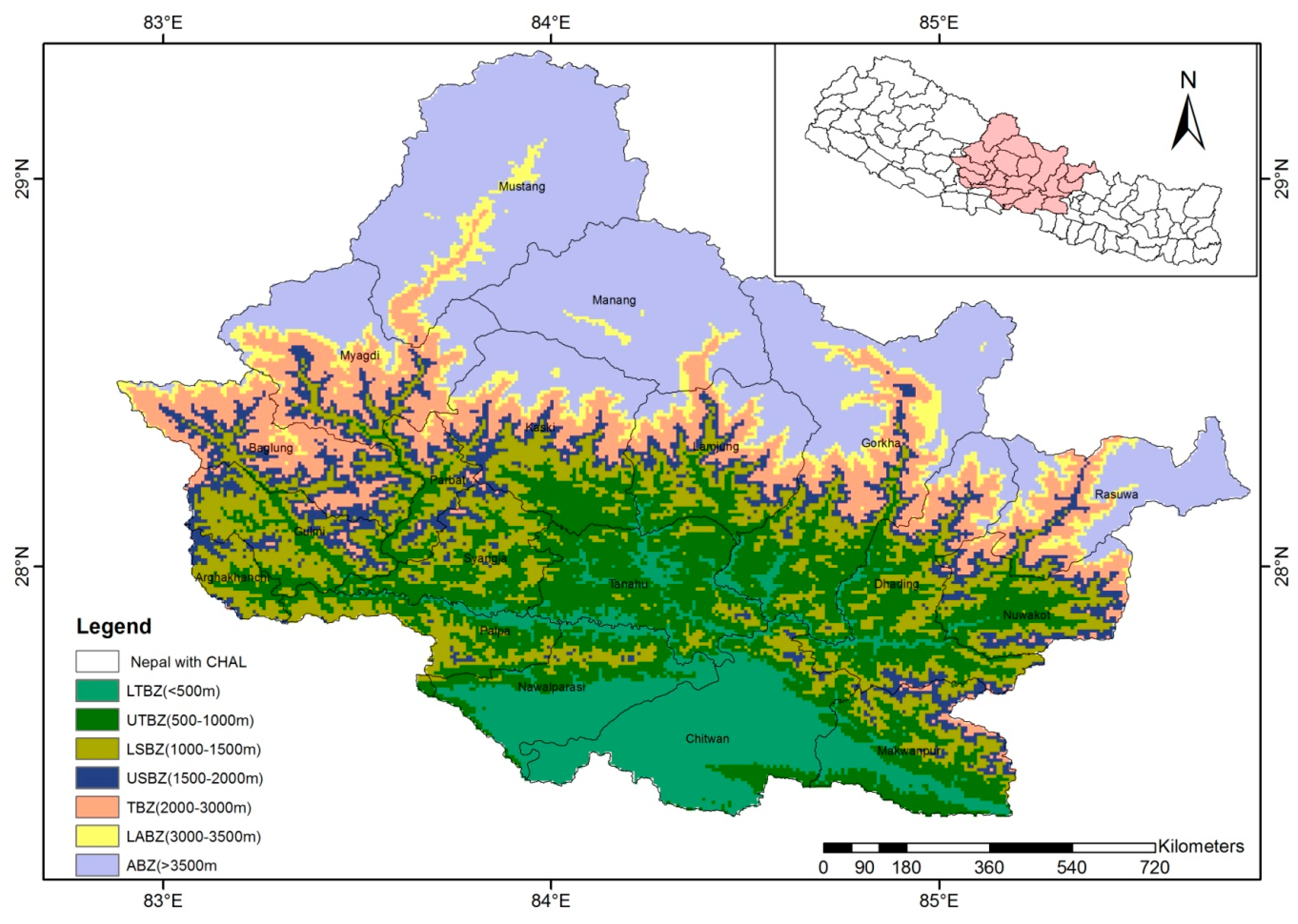
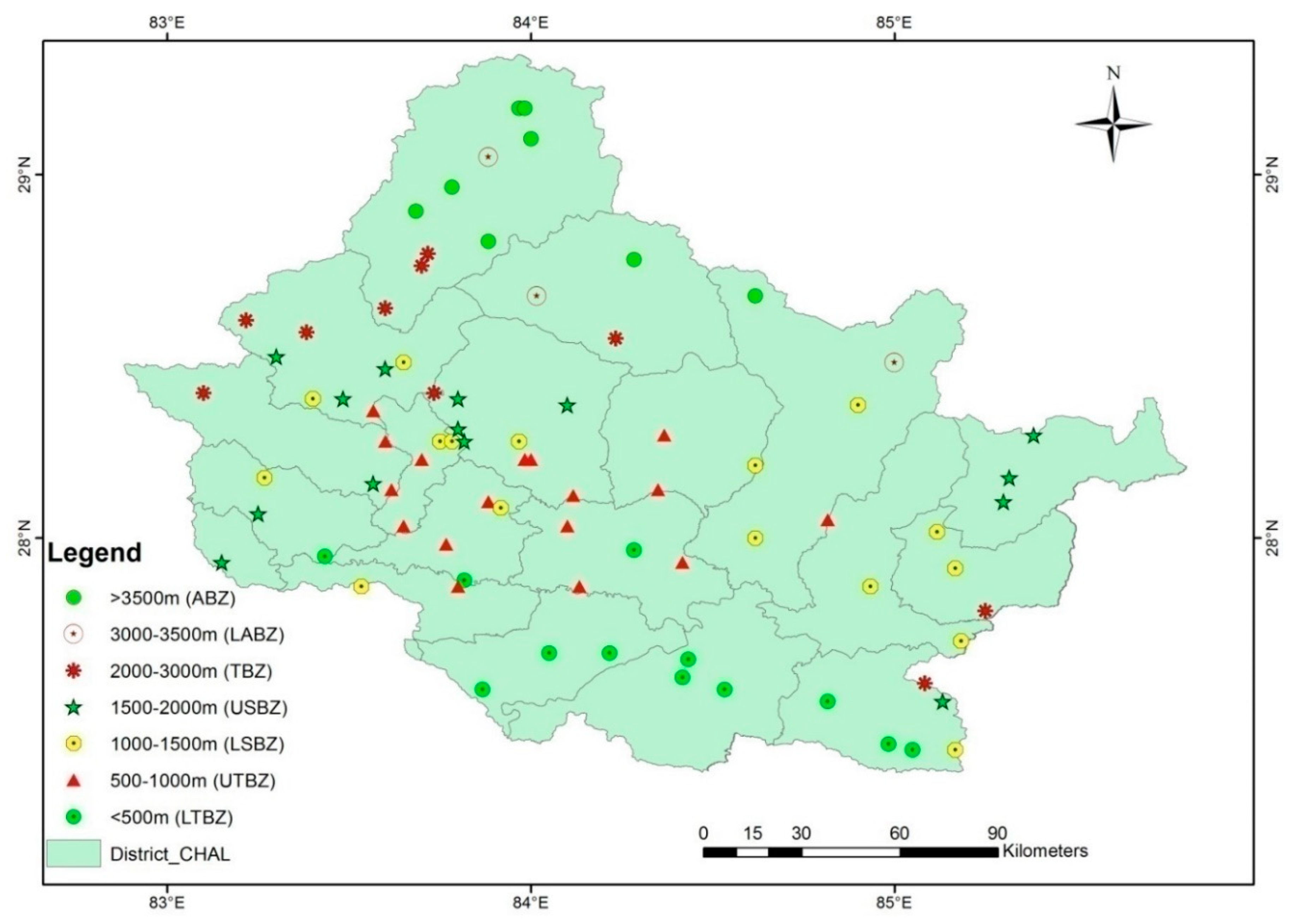

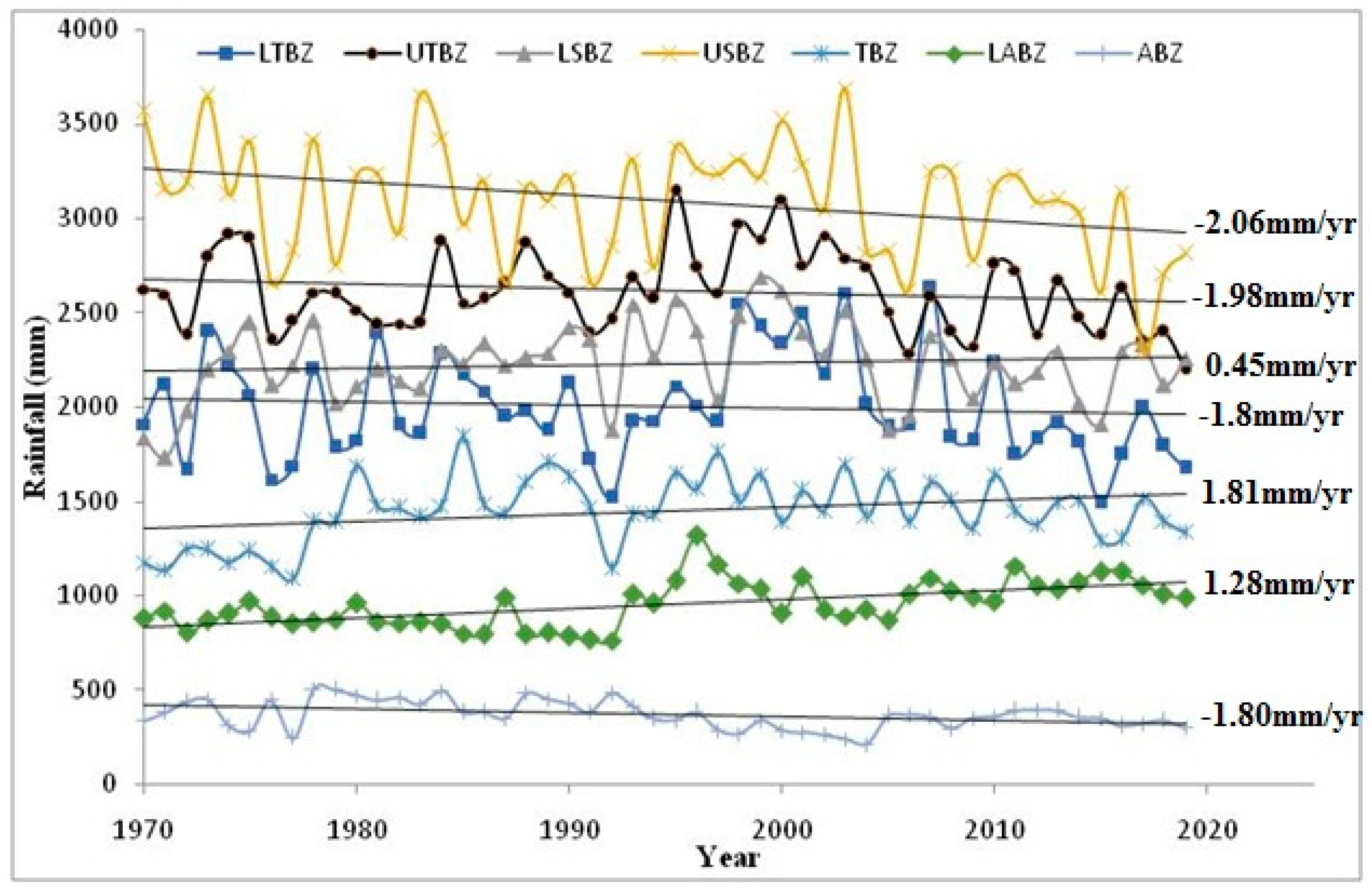
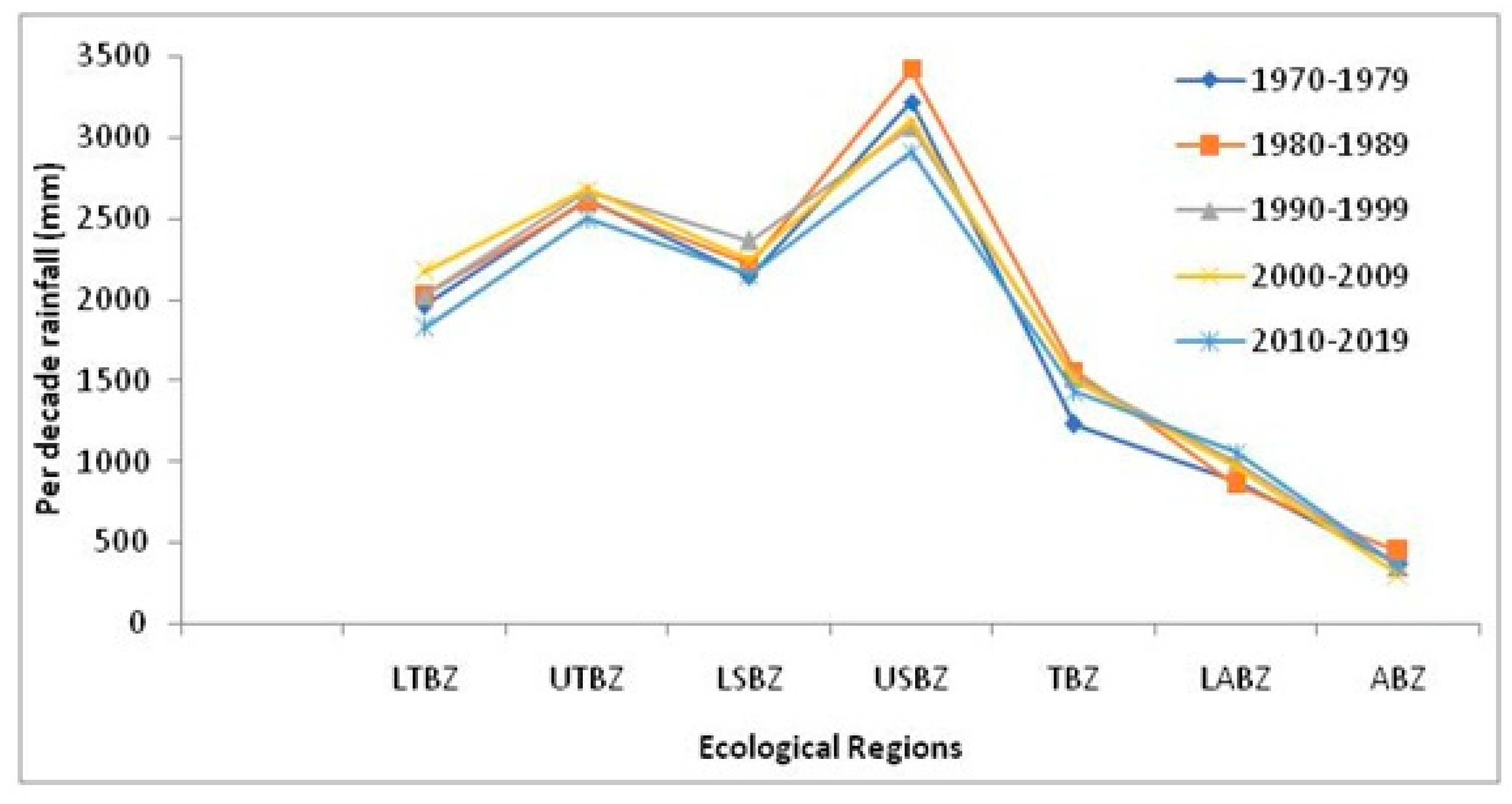
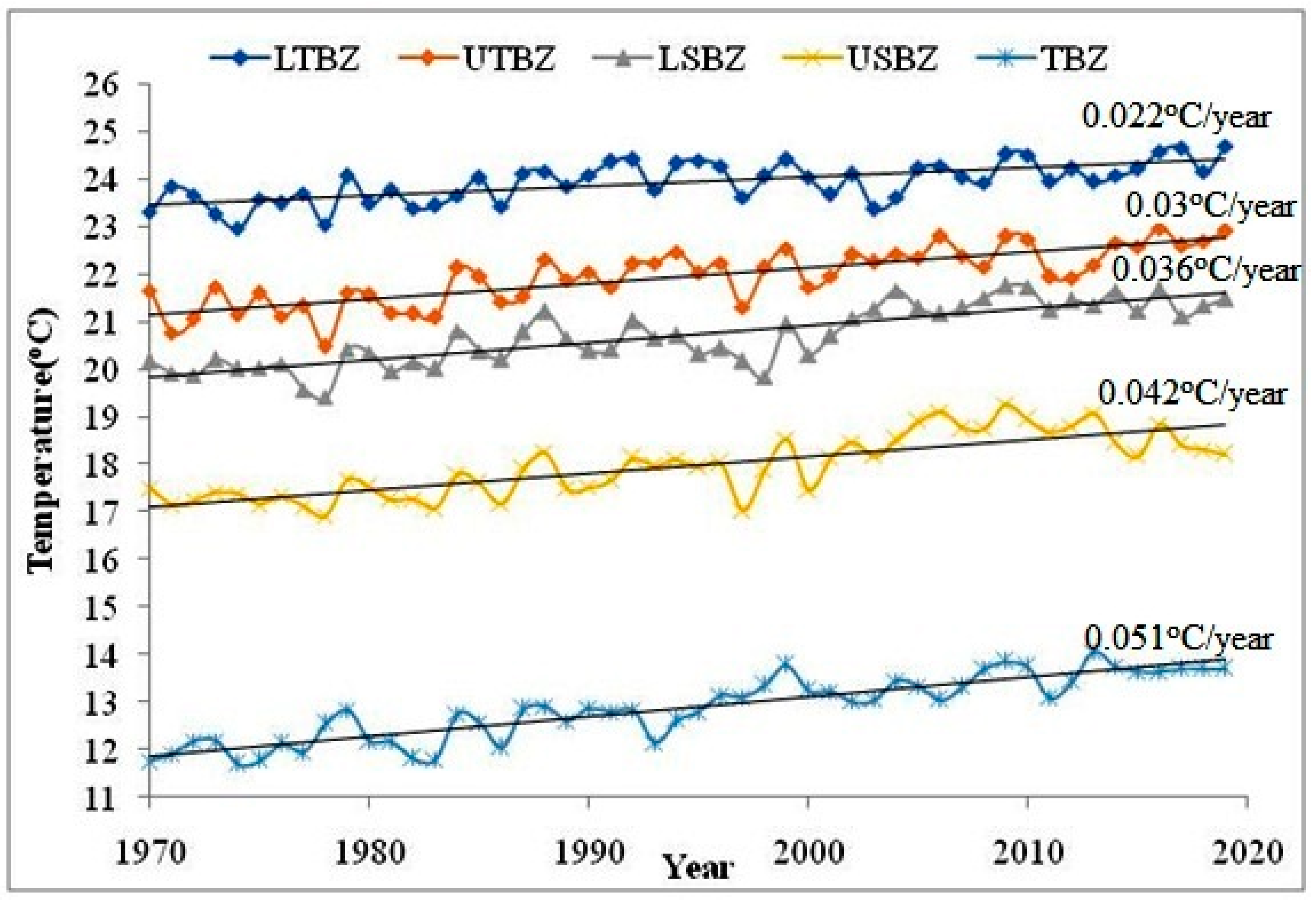
| Bioclimatic Zones | Precipitation Stations | Temperature Stations |
|---|---|---|
| LTBZ (<500 m) | 14(11) | 6(5) |
| UTBZ (500–1000 m) | 16(11) | 10(8) |
| LSBZ (1000–1500 m) | 16(10) | 4(4) |
| USBZ (1500–2000 m) | 14(8) | 5(4) |
| TBZ (2000–3000 m) | 10(7) | 7(5) |
| LABZ (3000–3500 m) | 3(2) | - |
| ABZ (>3500 m) | 8(3) | - |
| Total | 81(52) | 32(26) |
| Bioclimatic Zones | 1970–1979 | 1980–1989 | 1990–1999 | 2000–2009 | 2010–2019 | Trends between 1970–2019 | ||
|---|---|---|---|---|---|---|---|---|
| Sen’s Slope Per Year | p Value (Mann- Kendall Test) | Significance | ||||||
| LTBZ | 1964.4 | 2030.5 | 2022.3 | 2169.3 | 1823.6 | −1.8 | 0.029 | No |
| UTBZ | 2620.8 | 2604.6 | 2665.7 | 2677.8 | 2496.3 | −1.98 | 0.47 | No |
| LSBZ | 2145.8 | 2216.0 | 2362.1 | 2242.8 | 2152.8 | 0.45 | 0.89 | No |
| USBZ | 3222.5 | 3422.9 | 3066.9 | 3105.5 | 2913.79 | −2.06 | 0.03 | Yes |
| TBZ | 1230.2 | 1558.1 | 1519.65 | 1498.75 | 1429.25 | 1.81 | 0.002 | Yes |
| LABZ | 886.2 | 854.8 | 992.1 | 971.1 | 1056.2 | 1.28 | 0.0001 | Yes |
| ABZ | 366.8 | 444.3 | 351.1 | 298.4 | 348.0 | −1.80 | 0.05 | Yes |
| Bioclimatic Zones | Sen’s Slope | p Value (Mann-Kendall Test) | Significance |
|---|---|---|---|
| LTBZ | 0.022 | <0.001 | Yes |
| UTBZ | 0.030 | <0.00001 | Yes |
| LSBZ | 0.036 | <0.0001 | Yes |
| USBZ | 0.042 | <0.00001 | Yes |
| TBZ | 0.051 | <0.0001 | Yes |
| Bioclimatic Zones | 1979–1989 | 1989–1999 | 1999–2009 | 2009–2019 | 1979–2019 | |
|---|---|---|---|---|---|---|
| Sen’s Slope | Significance | |||||
| LTBZ | 0.26 | 0.27 | 0.16 | 0.19 | 0.022 | Yes |
| UTBZ | 0.28 | 0.28 | 0.33 | 0.32 | 0.030 | Yes |
| LSBZ | 0.17 | 0.39 | 0.44 | 0.42 | 0.036 | Yes |
| USBZ | 0.36 | 0.39 | 0.44 | 0.47 | 0.042 | Yes |
| TBZ | 0.48 | 0.51 | 0.56 | 0.52 | 0.051 | Yes |
| Bioclimatic Zones | AAT (°C) | TLR (°C/500 m) | TLR (°C/km) | ANR (mm) | PLR (mm/500 m) | PLR (mm/km) |
|---|---|---|---|---|---|---|
| Lower tropical bioclimatic zone (<500 m) | 24.1 | - | 2002.1 | - | ||
| Upper tropical bioclimatic zone (500–1000 m) | 21.8 | −2.3 | −4.6 | 2613.1 | 611 | 1222 |
| Lower subtropical bioclimatic zone (1000–1500 m) | 19.7 | −2.1 | −4.2 | 2223.9 | −389.2 | −778.4 |
| Upper subtropical bioclimatic zone (1500–2000 m) | 17.5 | −2.2 | −4.4 | 3146.4 | 922.5 | 1845 |
| Temperate bio- climatic zone (2000–3000 m) | 13.3 | −2.2 | −4.4 | 1447.2 | −849.6 | −1699.2 |
| Lower subalpine bioclimatic zone (3000–3500 m) | 952.1 | −495.1 | −990.2 | |||
| Alpine bioclimatic zone (>3500 m) | 361.7 | −590.4 | −1180.8 |
Publisher’s Note: MDPI stays neutral with regard to jurisdictional claims in published maps and institutional affiliations. |
© 2020 by the authors. Licensee MDPI, Basel, Switzerland. This article is an open access article distributed under the terms and conditions of the Creative Commons Attribution (CC BY) license (http://creativecommons.org/licenses/by/4.0/).
Share and Cite
Luitel, D.R.; Jha, P.K.; Siwakoti, M.; Shrestha, M.L.; Munniappan, R. Climatic Trends in Different Bioclimatic Zones in the Chitwan Annapurna Landscape, Nepal. Climate 2020, 8, 136. https://doi.org/10.3390/cli8110136
Luitel DR, Jha PK, Siwakoti M, Shrestha ML, Munniappan R. Climatic Trends in Different Bioclimatic Zones in the Chitwan Annapurna Landscape, Nepal. Climate. 2020; 8(11):136. https://doi.org/10.3390/cli8110136
Chicago/Turabian StyleLuitel, Dol Raj, Pramod K. Jha, Mohan Siwakoti, Madan Lall Shrestha, and Rangaswamy Munniappan. 2020. "Climatic Trends in Different Bioclimatic Zones in the Chitwan Annapurna Landscape, Nepal" Climate 8, no. 11: 136. https://doi.org/10.3390/cli8110136
APA StyleLuitel, D. R., Jha, P. K., Siwakoti, M., Shrestha, M. L., & Munniappan, R. (2020). Climatic Trends in Different Bioclimatic Zones in the Chitwan Annapurna Landscape, Nepal. Climate, 8(11), 136. https://doi.org/10.3390/cli8110136





